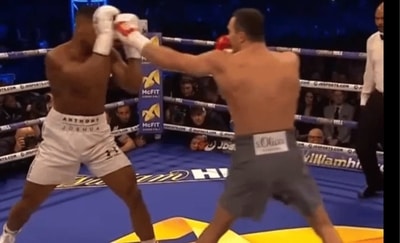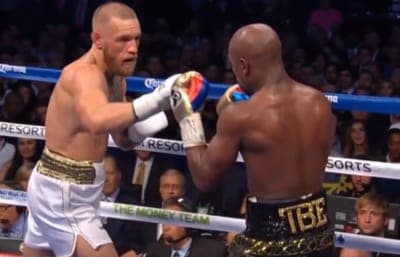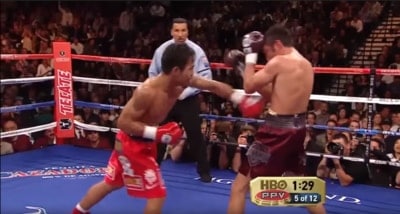
To be a short person who just starts boxing sometimes can be really discouraging. Because, when you spar against these tall guys, it’s hard to find the right range to land your punches. The taller boxers will usually use their jabs to keep you at a distance and avoid the close-distance fighting. So before you learn how to counter their style, sparring with them can be really tough.
In case you are shorter than the average height of boxers in your weight class you are a clear range disadvantage. But that doesn’t mean you can’t be successful.
After you gain some experience, you will find out that being short in boxing isn’t that bad. And actually, there some benefits. Let’s dive into the ways, you can use your height disadvantage to, actually, take the upper hand in a boxing match (or in sparring).
1. In-fighting advantage
In boxing, in-fighting or fighting from the inside means basically boxing in a short distance. The boxers who fight from the inside are called in-fighters or swarmers. The majority of the short boxers fight from the inside because that way they can negate the reach advantage of their longer opponents. That’s because when you are a tall boxer and you have a long reach you need enough space to use it. And when you don’t have that space, your reach becomes useless.
On the other hand, the boxers with short reaches can easily land some hooks or uppercuts when fighting from the inside. For instance, one of the best inside-fighting tactics is to trap your rival against the ropes and then start landing combinations. You can go to the body at first and then to the head, so you can catch your the other boxer off guard.
The other problem of the taller boxers when fighting against swarmers is that they are usually overwhelmed by the constant pressure their opponents apply. That can make them panic which makes them easier targets.
So this type of boxing can be really effective against taller fighters. But before you can start fighting from the inside, you need to close the distance between you and your opponent. And that isn’t so easy to do. The boxers with longer reaches will try to catch you with long straight punches. To dodge these shots, you need to develop good head movement so you can slip them. And you will also need good footwork, so you can close the distance right after you slip these punches.
Are you ready to get your boxing to the next level?
Watch a FREE Online Boxing Course by the boxing coach Brandon Ray!
You’ll learn:
1. How to fight bigger/taller opponents
2. How to close the distance without getting hit
3. Defense and Offense in the pocket
2. More punching power
When you have knockout power, no matter if the other boxer has better technique, better cardio or more experience, if you catch him clean, even ones, that can end the match.
If you look at fighters such as Mike Tyson or Joe Frazier, you will notice that they don’t have long reaches, but their punching power is something really scary. I am not sure why exactly, but obviously, in the most cases, the shorter boxers have more punching power than the taller ones. They also punch faster and are usually more explosive. Here are some of the possible reasons why is that:
- Leg muscles – When a boxer fights against a taller opponent, they are punching upwards. Thus they are using their leg muscles more when punching, which increases the power of the shot.
- More muscle mass – When you are shorter than someone, but you weigh the same weight, you will probably have more muscle mass. And the more muscle mass you have the more explosive you are. And more explosiveness = more punching power.
- Faster body rotation – The force equals mass multiplied by acceleration. So the faster you can rotate your body with your punches the more powerful they will be. In most cases, shorter people are usually faster and agiler than taller ones. Which is probably one of the reasons why they are bigger punchers.
Yes, the fighters with longer reaches, usually have more powerful straight punches. Because of the long-distance the punch travels and the momentum that is generated. But the shorter boxers have much more explosive hooks, overhands, and uppercuts. Their punches are also much faster and it’s harder to defend them.
And like Myke Tyson said, “the punches you don’t see, usually cause the knockout”. That’s because when you don’t see the punch that is coming, you aren’t flexing your neck muscles which can dampen the punch. So that may be another reason why the shorter boxers have more knockout power.
3. Devastating body punches
The body punches can be really effective in a boxing match. With a good body shot, you can knock the wind out of your opponent, which will make him gas out more quickly (especially in the later rounds where the exhaustion takes place).
The most effective body punches are the uppercuts to the body. These are close-distance punches, and like we already know the shorter boxers have an advantage in the close distance fighting. Also, their uppercuts and hooks are much more powerful and explosive, compared to the hooks and the uppercuts of the taller boxers.
There are 2 different purposes for which the body shots can be used. Let’s dive into them:
1. To hurt your opponent’s body
I know this is quite obvious but you need to know how to do it correctly when you fight against a taller boxer:
The best place to land a body punch is on the liver. It’s located right below the ribs, on the right side of your opponent’s body. So to land a liver shot, you need to throw a LEFT punch. It’s a very effective technique especially if you are a southpaw fighter. Because then your left hand is your power hand, which makes the shot even more devastating.
But you can’t just throw a “naked” body punch from a distance. Because your rival will see it from a mile away and will block it, dodge it or just counterpunch you with a straight punch. That’s why you need to mask it somehow. For instance, I like to mask it, using straight punches combinations. Here are the best combinations I like to use:
Orthodox combinations:
When you are an orthodox boxer, your left hand is actually your lead hand. So it’s easier to land a liver shot because your lead hand is close to your opponent’s right side. But still, to land the body shot clean, you need to mask it. Here is my favorite combination to do that:
- Jab to the head
- Right cross to the head
- Left uppercut to the liver
The straight punches are a great weapon if you are at a distance from the other fighter. But to land the uppercut to the liver, you need to close that distance. To do that, you need to step forward as you throw the jab. Then you will be at the right range to land the uppercut.
Also, remember that the first two punches – the jab and the cross are only a set up for the liver shot. So you don’t need to commit to them. You can throw them with less power, just to mask your step and the punch to the body (which you can throw with bigger power).
Southpaw combination:
As I already mentioned, the southpaws liver punches can be really devastating. But the problem here is that you hit your opponent with your power hand (your left hand), which makes the punch even more telegraphed because of the longer distance it travels. Also, the taller boxers will try to keep you at a distance. So you need a combination that will help you to mask your steps so you can come closer and land the liver shot. Here is a great combo you can use to do that:
- Jab to the head
- Make a step with the jab
- Jab to the head
- Make one more step
- Left uppercut to the liver
The double jab will help you to distract your opponent’s attention from your legs, while you stepping forward. And again, the purpose of the jabs is to set up the bigger punch, not to hurt. So don’t commit to them too much.
2. To set up head punches
The second purpose of the body shots is to set up head punches. The idea is to make your opponent defend his body so you can land some clean shots to the head. A great situation when that can work is when you trap your taller rival against the ropes or in the corner. Then you can throw 1 or 2 uppercuts to the body and then uppercut/hook to the head. It’s really effective.
Fighters such as Mike Tyson used similar combinations all the time. Just be careful to not come too close to the other boxer so he can enter in a clinch. You need to be just at the right distance where he can’t escape but he also can’t use the clinch to stop you.
4. Speed advantage
“He who hits and runs away lives to fight another day’.” – Willie “Pep” Papaleo – American boxer, competed between 1937 and 1966.
To be faster than your opponent can be really beneficial. You can escape easily when you are in a bad situation, but you can also attack and then go back to a safe distance very quickly.
Usually, the shorter boxers have a speed advantage. That’s because they are just agiler than the taller ones. Most of the times their hand speed is also better. Which is really important too, especially if you are a combination puncher.
5. Better balance
The shorter people have a lower center of gravity than the taller ones. So their balance is usually better. And in boxing, your balance is really important, especially when you are throwing heavy punches, such as power hand hooks, or overhands.
Also, it’s harder for your opponent to push you down. That really matters, because, many of the knockdowns in the boxing matches are actually caused not by a powerful punch, but by a loss of balance after a push. But the referee may score that as a knockdown and the boxer who was pushed may lose points. And sometimes that can be a deciding factor for the result of the fight.
6. Better defense
In boxing, a tall person = a bigger target. That’s because when you are tall, it’s harder for you to defend yourself everywhere all the time. For example, when you throw jabs or straight punches, your body is exposed for uppercuts or hooks. And your rival just needs to slip one of these punches, to close the distance and to start working on your body.
On the other hand, if you are shorter it’s much easier to defend yourself. Your body is a smaller target and it’s harder to be hit while your head is protected by the big boxing gloves that you wear.
7. Bob and weave
There are many ways you can defend from incoming punches. You can block them, parry them, lean back or even hop back to avoid them. Some of these ways, for example, blocking, are safer than other. Because when you block, your gloves will dramatically decrease the impact of the punch. But while doing that, you are covering yourself up and it’s harder to counter your opponent. That’s why blocking is a low risk – low reward type of defense.
On the other hand, the “highest risk – highest reward” defensive tactics are slipping and bobbing and weaving. To slip the punch means to move your head to either side, so you can dodge it. And bobbing is to move your head beneath the punch. These defense techniques are a risky move because you can get caught while using them. For example, the other fighter may feint a straight punch to make you bob and then catch you with an uppercut. Which can be really devastating. But they are the “highest reward” ones because using them you can counterpunch your opponent right after he misses you when he is exposed. That’s a great way to knock someone out.
And the shorter boxers have an advantage here also. That’s because, as we already know, their center of gravity is closer to the ground so they can stay balanced while bobbing and weaving. They are also quicker, so they can execute the technique much faster.
Also, this technique is very effective against taller boxers, because they are throwing mostly straights. And the easiest way to dodge a straight punch is by slipping or bobbing and weaving.
8. Easier to cut weight
If you are competing in a real boxing match you will need to make a certain weight, depending on the category in which you want to compete. Otherwise, you won’t be allowed to fight.
Generally, the taller you are the more weight you need to cut (simply because, you just weigh more). That means that you lose more muscle mass, compared to a shorter guy from the same category. So you will be less explosive during the fight. Also, you will have less energy, because of the fewer calories you can take, to make the necessary weight, which can be a huge problem in a fight.
On the other hand, the shorter boxers can save more of their muscle mass and energy during the weight cut. That way they will be more explosive and will have better endurance when is time for action.
9. Better control in the clinch
Have you noticed that the powerlifters usually aren’t very tall and their arms are also short? That’s because the longer the arms of a person are, the more the weight is multiplied in proportion to the full extension. So the short arms are actually an advantage in weightlifting. Because a person with short arms can lift more and control the weight much better than someone with longer arms.
You are probably wondering how is that related to boxing. Here is how: In boxing, there is a situation where you can apply that. And that situation is clinching. If you have shorter arms it’s much easier for you to control your opponent in the clinch and vice versa. That’s because the physics is on your side.
You can use that advantage to push the other boxer against the ropes or just push him back so you can get out of the clinch.
10. An advantage over the outside boxing style
The fighters who are using the outside boxing style are called out-boxers. They like to maintain distance from their opponents using their jabs a lot and also their footwork. A great example of an out-boxer is Muhammad Ali. He liked to circle around his opponents and to throw mainly jabs and right straights.
Such boxers are doing extremely well against slow fighters with poor footwork. But the in-fighters (or the swarmers) can really give them trouble. That’s because of the constant pressure the swarmers apply and the short-distance fighting where they can’t use their reach advantage.
When you are a beginner, you may find it really hard to spar against tall guys. But at the higher level of boxing, the in-fighting style is actually countering the out-boxing one. You can see that if you watch how fighters such as Mike Tyson destroyed their taller rivals.
11. More exciting to watch
Sometimes the out-boxers can make a really great show. A great example of that is the heavyweight boxer, Deontay Wilder who is an exciting knockout artist. But on the amateur level (for example the sparring in the gym) the out-boxing style isn’t so fun to watch. Because the out-boxers use their mainly jabs and avoid the exchanges, which isn’t the most exciting way to box.
On the other hand, the swarmers get into exchanges and use counterpunching much more often which is really exciting to watch.
That’s why I honestly prefer watching two swarmers fighting or a swarmer against out-boxer than just two out-boxers trading jabs and circling around.
And that’s the last benefit that comes to my mind:
If you are a short boxer, chances are that you are swarmer. So your boxing style is the most exciting style to watch which will get you more fans and popularity (or at least you will look cool when you show the videos of your sparring to your friends:)
If you are a short boxer, chances are that you are swarmer. So your boxing style is the most exciting style to watch which will get you more fans and popularity (or at least you will look cool when you show the videos of your sparring to your friends:)




That was a good read, man. I’m 5’10” and 210lbs and have gotten back into boxing again. Ha, what you wrote there is true. All of its true. When I was younger I hit very hard but I was slow, didn’t move, took massive punches and let the other other fighter dictate the bout. But now I swarm and attack at all times. I hit even harder and don’t get smashed up anymore because of good cardio, good head movement, good footwork and be able put the other guy down and out for good. I hope more people read what you wrote here and that it gets more short, fearless and powerful boxers into the ring.
This was really helpful. I’m 5’2, I weigh 93 pounds. I’ve been wanting to get into a martial arts style, and I’ve always admired boxing. However, I was extremely discouraged due to my size. This has really helped give me a a bit of insight as to the fact that this might not be as impossible as I had originally thought! Thank you! ❤
I’m glad it helped you!!! Keep training and you’ll see the results!
Thanks for the piece… I’m 5’6″ with arms that are short even for my height, a little bit under 160 lbs with little fat to lose and a southpaw. My coach insists that I use the more traditional boxing stance with a long lead arm almost constantly pawing the opponents lead arm (given that they are orthodox), but I’m really finding it hard to understand how that could be even slightly appropiate for someone of my physique. He says it’s to distract my opponent and keep my range but I feel it really leaves the centre and right side open because I don’t think there’s anyone in my gym that has shorter arms. What do you think? And what guard would you reccomend and why?